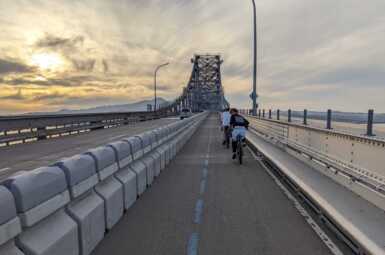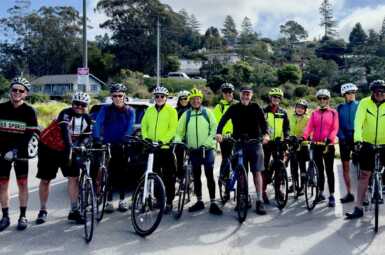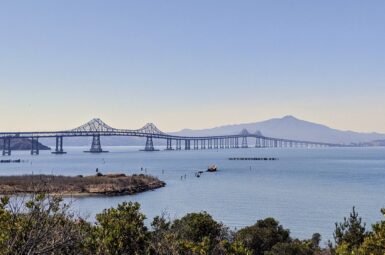November 2022 Election 2022 San Rafael City Council Candidate Questionnaire
As a 501(c)3 nonprofit organization, Marin County Bicycle Coalition cannot endorse candidates for public office, but we are able to share information so that you can arrive at your own conclusion. Below are the 2022 City of San Rafael candidates’ responses to our questionnaire on bicycling in Marin. We have made no content changes. Thanks to the candidates for their time and thoughtful answers.
Candidates’ campaign websites may be accessed by clicking on those with a highlighted name. Those who did not provide a campaign website are not highlighted.
Here are the candidates on the November ballot for the City of San Rafael:
City of San Rafael District 2
-
Gerrod Herndon
City of San Rafael District 3
-
Jonathan Frieman
Personal Travel
1. Do you ride a bicycle? If so, for what purposes and how often? (transportation/road/mtb)
District 2
Gerrod Herndon: No response
Eli Hill:
-
a. Commuting: Never
-
b. Errands: Never
-
c. Road recreational: Never to occasional
-
d. Mountain biking or trails: Never
I occasionally ride a bike recreationally.
District 3
Maribeth Bushey:
-
a. Commuting:
-
b. Errands:
-
c. Road recreational:
-
d. Mountain biking or trails:
Yes. I ride my bike primarily for errands and on the road for recreational purposes about once a week.
Jonathan Frieman:
-
a. Commuting: Never
-
b. Errands: Sometimes, about once a month
-
c. Road recreational: About 2 to 3 days a week
-
d. Mountain biking or trails: Every once in a while
2. If you own a bike, what type of bike(s) do you have and ride? If not, when was the last time you rode a bike, and where (on vacation, for example)?
District 2
Gerrod Herndon: No response
Eli Hill:
I own a utility hybrid.
District 3
Maribeth Bushey:
My bike is a well-worn standard street bike.
Jonathan Frieman:
I own 3 bikes: a Jamis hybrid Tangier that is about 20 years old; an Orbea road bike, and a Riese-Mueller e-bike, a Mixte: Class 3.
Vision
3. In your own words, describe your vision for the future of transportation in San Rafael.
District 2
Gerrod Herndon: No response
Eli Hill:
San Rafael has the potential to become a public transit hub and a place in which community members who would utilize safe alternatives to cars can do so. As best described in the San Rafael Bicycle and Pedestrian Master plan the goals are to:
-
Make San Rafael an excellent place to walk and bicycle and reduce overall carbon emissions by increasing the number of residents who walk and bike
-
Gather public input to help identify and guide investments in pedestrian and bicycle facilities over the next 5 to 10 years
District 3
Maribeth Bushey:
Super interesting and very pertinent question. Post-pandemic the daily migration to and from offices has substantially decreased. I rode transit to work in San Francisco for many years. Travel into the City has decreased substantially, Golden Gate Transit statistics here. I haven’t regularly commuted to an office since March 2020 and I don’t foresee that changing.
The future of transportation in San Rafael will be different from its past. With the daily commute patterns probably permanently changed, the future will be less predictable in volume and direction. That change is already impacting our transit agencies.
With outbound commuting reduced, San Rafael residents remain here and are making more local trips during the day, or so it seems.this is actively being studied by transit agencies as we work together to shape the response to changing travel patterns while keeping transit opportunities available
Jonathan Frieman:
San Rafael is so decentralized geographically that there are least 3 distinct areas at some distance from each other–a unified vision and plan may not be the most realistic goal.
San Rafael faces a number of transportation flow challenges. Highway 101 carries about 100,000 people going South every weekday morning—that creates traffic congestion going east and west about 4 or 5 times a day: the morning rush hour; the noon lunch hour at SR Hi; when SR Hi lets out; and the evening rush hour. Additionally, the empty train cuts through downtown and adds to congestion. The bike paths alongside a good portion of those tracks are mostly used for recreation rather than commuting.
One way to attract bicyclists from Gerstle Park, Bret Harte, the Canal, and East San Rafael is to close the part of the downtown section of 4th Street to cars. That might get us closer to increasing bike usage.
Traffic
A large proportion of peak hour traffic is made of people driving their children to school. While some people live too far to easily walk or bike to school, many parents are simply afraid to let their children travel by foot or by bicycle because of the high volume and speeds of car traffic.
4. What strategies would make more parents feel safe with their children walking or biking to school, thereby reducing traffic and making everyone else’s trip to school a little safer?
District 2
Gerrod Herndon: No response
Eli Hill:
Traffic safety needs to be a huge priority for our entire community. We are hearing too many stories about community members who experienced traffic accidents while walking or biking. Increasing and supporting the infrastructure for bikers and pedestrians to feel safe on our streets, especially in high traffic areas is part of what would encourage parents and families to take advantage of non-carbon emission modes of travel. Specifically, the East/West and North/South bicycle corridors intersecting at the San Rafael Transit Center have several sections that need to be completed so that they are usable end-to-end.
District 3
Maribeth Bushey:
My first strategy was implemented, much to my children’s chagrin, when they rode their bikes to Glenwood Elementary School – orange safety flags on bikes!
The Safe Routes to School program is also a long standing and very successful strategy. The City in collaboration with the school districts uses this program to fund the improvements to help parents and the entire community be safe as students walk or bike to school.
Jonathan Frieman:
The first step is to work with Safe Routes to Schools, https://www.saferoutestoschools.org/. Involving community organizations is critical to determining where students are living in relation to their schools, and then ensuring safe routes using bike paths and sidewalks.
It is important to also take note of the many students do who walk to school, such as from the Canal area to the high school. It is a matter of fairness and environmental justice that, in addition to increasing the number of students who walk to school, we must ensure that those who already walk to school are safe and as far from car pollution as possible.
A survey from the Transportation Authority of Marin (Figure 18, p. 51) found that over half of Marinites would like to bike more than they currently do. This backs up research that shows that over 50% of adults are interested in biking, but concerned about the threat of fast-moving cars.
5. What concrete steps can be taken to allay these concerns and make people feel safe on bicycles?
District 2
Gerrod Herndon: No response
Eli Hill:
Protected bike lanes are necessary to keep bikers safe on the road. Many neighbors have expressed their opinion on this in District 2, but we need to reduce our reliance on cars. Building and maintaining the infrastructure for cyclists and pedestrians as well.
District 3
Maribeth Bushey:
The literally concrete steps are being taken on in the City’s Third Street renovation project – a project I voted to approve. Similarly, the bike path along the SMART train in San Rafael, also a City-funded project I voted to approve.
Jonathan Frieman:
A look at the numbers helps put things into perspective: the county has 255,000, and half of the ideal situation posed by the question means 125,000 people are biking every day. That also means 30,000 people in San Rafael
The most bike-friendly communities almost always have much greater density than San Rafael. While getting half the population to actually bike may be unachievable, investing more in bike safety infrastructure should help.
Safety
Traffic deaths and injuries are on the rise, both nationally and in Marin (this includes all road users, not just bicyclists). Many cities in California have enacted so-called Vision Zero
resolutions, setting an explicit goal to eliminate traffic deaths.
6. If elected to town Council, will you support such a resolution? If so, what actions do you see as being needed to improve safety? What are the relative roles of infrastructure, enforcement, and education?
District 2
Gerrod Herndon: No response
Eli Hill:
I believe it to be the role of the City to educate community members and to maintain the City’s infrastructure. Enforcement is always a capacity issue but I am open to hearing more ideas from community members about how enforcement can improve to prevent any accidents. All three of infrastructure, enforcement, and education/engagement are needed to move toward Vision Zero; each must be continuously examined and improved.
District 3
Maribeth Bushey:
I would be open to considering a Vision Zero resolution, especially with input from our Bike and Pedestrian Advisory Committee. Balancing infrastructure, enforcement, and education will be key decision points in considering a Vision Zero resolution.
Jonathan Frieman:
Yes, I would support such a resolution. Safety and traffic are ultimately interlinked, both are fundamentally about quality of life and feeling safe & peaceful. Good policies can lead to a life with more exercise all centered around a paradigmatic shift in the way human beings live.
Climate Change
The latest IPCC report states clearly that greenhouse gas emissions need to be reduced quickly in order to stave off the worst effects of climate change. According to San Rafael’s most recent Greenhouse Gas Inventory, transportation accounts for a majority (53%) of local greenhouse gas emissions. Given that battery electric cars make up 3% of California’s vehicle
fleet, and only 12% of new cars sold.
7. does reducing overall driving have a role in meeting our climate targets? If so, what policies can support transit, walking, and bicycling in place of driving for short trips?
District 2
Gerrod Herndon: No response
Eli Hill:
Yes and I am very committed to getting cars off the road as much as possible. As I mentioned above, we have a huge opportunity to expand San Rafael’s transit hub.
District 3
Maribeth Bushey:
I have been an active supporter of San Rafael’s Climate Change Action Plan since its inception. Our last two General Plans, both of which I worked on and supported, have included numerous policies and actions to reduce automobile use for all trips.
Jonathan Frieman:
Yes, reducing overall driving has a significant role in meeting our climate targets. Our perspective in this moment in time means we look to government policies such as ensuring that only electric cars be sold after a certain date. There very well could be a dramatic shift in what kinds of cars we drive.
Project Delivery
Bicycle/pedestrian plan implementation is notoriously slow with typically fewer than one new bike lane project opening every year.
8. What steps would you take to hasten the project delivery process from inception to ribbon-cutting?
District 2
Gerrod Herndon: No response
Eli Hill:
The Marin County Bicycle Coalition, the San Rafael Bicycle and Pedestrian Advisory Committee, and other stakeholders have identified and prioritized the projects to achieve end-to-end infrastructure for cyclists. As many of the projects involve multiple jurisdictions (CalTrans, County, etc), many stakeholders must be engaged. I will coordinate with these groups to accelerate shovel-readiness and align funding.
District 3
Maribeth Bushey:
This depends completely on the project. In San Rafael, we have an extensive planning process for our capital improvement projects with detailed priorities and study requirements. Bike lane projects often impact street paving planning, underground utilities and street lighting, to name a few. Adequately assessing all impacts of such projects is necessary for prudent planning of these long-lived projects.
Jonathan Frieman:
City staff would have an idea as to what kinds of grants would be available to generate such improvements at a quicker pace. They are aware of the developmental models, and where the city is increasing in density.
In all things, there is a tension between “perfect but slow” and “quick and good enough.” Recent years have seen a move toward so-called “quick-build” infrastructure, allowing reconfiguration of streets to facilitate safer walking/biking without a years-long engineering process. While quick-build projects may be less aesthetically pleasing than the standard process, they are cheaper and happen much faster.
9. How do you rank aesthetic concerns of biking/waking infrastructure in comparison to those of cost and project speed?
District 2
Gerrod Herndon: No response
Eli Hill:
I agree with this framing; there are benefits and drawbacks to “perfect but slow” versus “quick and good enough”. I personally favor “quick and good enough” insofar as the immediate outcome is that additional community members would utilize these facilities, but am open to considering “perfect but slow” if there is evidence that this approach would result in better utilization. I am open to learning more.
District 3
Maribeth Bushey:
As with most significant public projects, the relative weight to be given to aesthetic concerns and cost/implementation timing will depend on the project. Highly visible projects merit greater consideration of aesthetics, and urgently needed projects justify a greater focus on implementation timing.
Jonathan Frieman:
Aesthetics will attract more people, so it’s imperative that not be sacrificed for speed of implementation. While there are ways to cut corners, both in expense and engineering, the look of a project should not be completely jettisoned. I’m confident in our engineering ability as humans that we’ll be able to cut down construction time as well as build products that please the eye and the soul.
Car Parking
Much of Marin has narrow streets, but on-street parking typically takes up between 30-40% of the street space between the curbs, and is often in tension with the need for dedicated bike lanes.
10. In your mind, are bike lanes ever sufficiently important to justify removing on-street parking, and in what circumstances would you consider that to be the case?
District 2
Gerrod Herndon: No response
Eli Hill:
This should be done on a case by case basis. Our neighbors in District 2 are very concerned with the lack of parking but I also think that we need to do more to promote non-car travel. I’m open and willing to listen to try and balance everyone’s concerns with the need to reduce car travel.
District 3
Maribeth Bushey:
This depends completely on the area of San Rafael. Conceptually, providing safe bike travel could in the right circumstances justify removing on-street parking.
Jonathan Frieman:
Yes. Fourth Street San Rafael is a perfect example where this should be implemented. Remove parking on both sides of the street and close down that street to car traffic. On-street parking is a euphemism for downtown, but San Pedro Road is an example where cars can park in the bike lane. That needs to be change, especially at San Pedro Elementary School.
11. Would you say that San Rafael has (A) not enough, (B) too much, or (C) just enough space dedicated to parking cars? If (A), what areas of town would you consider to convert to parking, and if (B) what would you do with the space that was previously parking?
District 2
Gerrod Herndon: No response
Eli Hill:
As we think about infrastructure, we need to think about how to incorporate different modes of travel. One of the concerns in District 2 in particular is wildfire danger and parking capacity has been reduced to ensure that emergency vehicles can navigate; many community members would prefer to not reduce capacity further given current dependency on cars. Additionally, the Downtown and West End Village is working through the balance of parking spaces allocated to Streetaries/Parklets to balance needs of businesses with patrons who typically drive. This said, I believe that there are a significant number of community members who would walk and cycle to get around if safe routes and adequate bicycle infrastructure were implemented. To this end, the San Rafael General Plan 2040 and Downtown Precise Plan, and San Rafael Bicycle and Pedestrian Master Plan each specify bicycle network and facility improvements. I support prioritizing implementation of these plans.
District 3
Maribeth Bushey:
This also depends completely on the area of San Rafael. We are currently working on a permanent policy for “streetaries” – outdoor dining areas for restaurants on public parking places. The Fire Department has designated several locations on relatively narrow streets where fire vehicles are not able to safely pass and parking is being removed.
Jonathan Frieman:
The answer depends on location. One place in Marin where there’s an obvious parking problem is in the Canal, due to overcrowding, lack of planning and neglect from City Hall. If elected, I would change this.
Bike Parking
Many MCBC members report challenges with bicycle parking in the downtown area. Racks are few and far between, or not easily visible from shops and areas with high levels of foot
traffic.
12. What steps or policies would you advance on the council agenda to bring about better bicycle parking and reduce the chance of bicycle theft?
District 2
Gerrod Herndon: No response
Eli Hill:
I support expanded bike parking as established in the San Rafael General Plan 2040 and Downtown Precise Plan, and San Rafael Bicycle and Pedestrian Master Plan. I support examination of inclusion of dedicated bicycle parking as part of the formula for new residential development.
District 3
Maribeth Bushey:
I will continue to listen to our Bicycle and Pedestrian Advisory Committee.
Jonathan Frieman:
I would create more bike parking racks. Again, safely locking them is important, and closed cages should be considered.
Due to recent changes in state law, the cities and towns of Marin are being compelled to zone for more multi-family housing. However, traffic is already unsustainable. To address this,
many cities have implemented what is known as Transportation Demand Management (TDM) in new developments, including replacing some car parking with bicycle parking, giving residents transit passes, or providing shared cars.
13. Do you support steps to require secure bike parking in new housing (and other policies to reduce driving), and, if so, how would you seek to implement them?
District 2
Gerrod Herndon: No response
Eli Hill:
Yes, I support increased bike parking in new developments.
District 3
Maribeth Bushey:
We have a decades-long history of requiring Transportation Demand Management Plans in projects across San Rafael. To be candid, most of them have not been very successful in reducing traffic. Bicycle parking is required and typically highly desired in multi-family housing in San Rafael.
Jonathan Frieman:
I do support secure bike parking in new housing. And the way to encourage this is by enforcing the matter at the introductory stages of development, and maintain that strong stance all the way through.
San Rafael-Specific Question
Thanks to new state law, commercial streets like 4th Street are eligible for lowered speed limits, which would reduce the likelihood and severity of crashes.
14. Do you support lowering the speed limit to 20 mph on busy commercial streets like this? Why or why not?
District 2
Gerrod Herndon: No response
Eli Hill:
In general, I support slowing down traffic on commercial streets in support of safety. I have worked with San Rafael staff to enhance infrastructure, enforcement, and education to this end. As to adopting a specific speed limit of 20 mph, I am open to analyzing and engaging the community and staff to understand benefits and impacts further.
District 3
Maribeth Bushey: No response
Jonathan Frieman:
Yes, and, as noted, I would go one step further and close Fourth to car traffic because that would render moot the speeding problem. It would also shift the entire character of downtown. I do support a lowered speed limit right now because it brings a calm to the city center. That allows people to relax and not have to worry about being victims of traffic accidents.
Wrap Up
15. Why should people who ride bikes (or those who want to ride bikes but don’t yet) vote for you?
District 2
Gerrod Herndon: No response
Eli Hill:
When I was appointed to the City Council in January of 2021, I made it a priority to talk to as many community members and neighbors as possible to get everyone’s input. Our County is changing and our community is changing. That means that our community needs to prepare for this change and transportation is one of the major ways in which we can make our community more resilient and climate-friendly.
District 3
Maribeth Bushey:
I have a proven track record of supporting public infrastructure projects to improve bike safety and enjoyment. I am in favor of expanding bike riding but the first priority must be safety for all residents and fiscal responsibility.
Jonathan Frieman:
Because I know bikes. I’ve been riding since I was 6 years old. I’ve done repairs on mine. And when I see a bike rider or a group of them, I check out their bikes, looking to see whether they are electric; new or old; what brand; and how the rider comports themselves. That kind of familiarity with the machine shows I have a deeper connection with the part of the body that is closest to the ground—the feet and the legs—and their constant movement. And that orientation—where we are bonded by the excitement of riding to a destination, such as City Hall or a restaurant, followed by the feeling that we still have to pedal home—creates a feeling of community, which is a mainstay of my campaign.
When I was on the Downtown Business Improvement District, I advocated for placemaking a la the Project for Public Spaces (https://www.pps.org/). I was met with resistance, and so I hope being elected to the city council will bring a stronger voice for helping to create love and a feeling of belonging to our community.
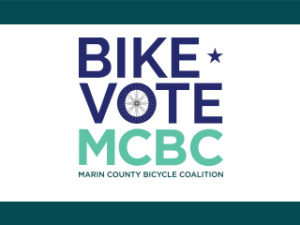
members make it happen!
We’re fighting for a more bike-friendly future in Marin. Are you with us? Join Marin County Bicycle Coalition today.
